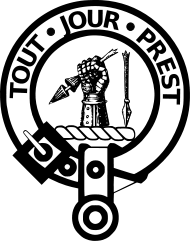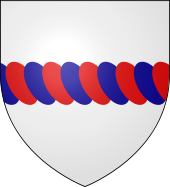- Clan Carmichael
-
Clan Carmichael Crest badge 
Crest: A dexter hand and arm in pale armed and holding a broken spear Proper Motto: Toujour prest Profile Region Lowlands District South Lanarkshire Gaelic name MacIlleMhicheil Chief

Richard Carmichael of Carmichael 30th Chief of the Name and Arms of Carmichael Seat Carmichael Allied clans Clan Douglas Contents
History
Origins of the clan
The name Carmichael originally comes from lands in Lanarkshire which were granted to Sir James Douglas of Clan Douglas in 1321, and let by his nephew William Douglas, 1st Earl of Douglas to Sir John Carmichael between 1374 and 1384.d
The name is also used to anglicise MacIlleMhicheil
Anglo-Scottish border conflicts
The Carmichaels were strong supporters of the Clan Douglas during their struggles for ascendancy, and were with them, fighting the English at the Battle of Otterburn in 1388 when the Scots defeated Henry 'Hotspur', Earl of Northumberland.
15th century
The Carmichaels were part of the Scottish Army sent to aid the French against English invasion, and at the Battle of Beauge in 1421 which was part of the Hundred Years' War. Tradition relates, Sir John Carmichael unseated the English commander, Clarence, in so doing broke his spear. This event, according to tradition, gained the Carmichaels their crest of a broken spear.
16th century
Katherine, daughter of Carmichael of Meadowflat, became a mistress of James V of Scotland and bore him a son who thus became half-brother to the ill-fated Mary, Queen of Scots. In 1546 Peter Carmichael of Balmedie was one of the murderers of the infamous Cardinal Beaton, and for his crime was sent to the 'galleys' where he shared penance with John Knox, 'father' of Protestantism in Scotland. Also Sir John Carmichael, was the keeper of Liddesdale, and commander of the Scots in the Raid of the Redeswire.
17th century and Civil War
Carmichaels were on both sides during Wars of the Three Kingdoms and English Civil War. Lord Carmichael stood on the side of King Charles I but two of his sons fought for the parliamentarians while the other two were Royalists. The brothers were reunited tragically at the Battle of Marston Moor in 1644, where one of the royalist sons, John Carmichael was killed fighting against his own elder brothers, one of whom commanded the Clydesdale Regiment.
In 1647 Sir James Carmichael became Lord Carmichael and his son became Earl of Hyndford in 1701. The principal family became allied to the Clan Anstruther by the marriage of Lady Margaret, daughter of the 2nd Earl, to Sir John Anstruther whose descendants inherited the Carmichael lands on the death of the 6th Earl of Hyndford in 1817. This family then took the name Carmichael – Anstruther which they continued until the succession of the present chief who resumed the family name in 1980.
Clan chief
The last direct male descendant of the senior branch of the family was Andrew Carmichael. He was the sixth Earl of Hyndford, 7th Lord Carmichael, 18th Baron and 23rd Chief of the Clan Carmichael who died unmarried in 1817.
The estate then passed to a direct descendant in the female line of the senior branch, while the chiefship passed to a direct male descendant of the Balmedie branch. In 1980, Richard Carmichael was a 32 year old aspiring accountant residing in New Zealand. Upon the death of his cousin Sir Windham Carmichael-Anstruther, the 25th Baron of Carmichael, he learned of his inheritance of the Barony of Carmichael.
The previous (29th) Chief, Evelyn George Carmichael of the Balmedie line, had died in 1959 so that the chiefship had become dormant. He had three daughters and Richard petitioned the Court of the Lord Lyon with the support of the eldest daughter, Hermione Colville, and was officially recognized in 1981 as both the 30th Chief of the Name and Arms, and the 26th Baron of Carmichael, by virtue of his being descended through the female line of James, second Earl of Hyndford and third Lord Carmichael. Thus, Richard reunited the Barony and the chiefship which had been separated since Andrew’s death in 1817.
Clan Castles
Castles belonging to the Carmichaels included Maudslie castle, Eastend, Carmichael house, Crawford Castle, Castlecraig and Fenton Tower.
Cadet Families
Cadet families included those of Meadowflat in Lanarkshire and Balmedie in Fife. Many Carmichaels in Galloway became MacMichaels', and in Argyll some MacMichaels became 'Carmichaels', and it is this latter race only who are allied with the Appin Stewarts.
Clan Tartan
[1] from the Carmichael Clan Website.
See also
External links
Scottish clans Clans with chiefs Agnew · Anstruther · Arbuthnott · Arthur · Bannerman · Barclay · Borthwick · Boyd · Boyle · Brodie · Broun · Bruce · Buchan · Burnett · Cameron · Campbell · Carmichael · Carnegie · Cathcart · Charteris · Chattan · Chisholm · Cochrane · Colquhoun · Colville · Cranstoun · Crichton · Cumming · Darroch · Davidson · Dewar · Drummond · Dunbar · Dundas · Durie · Elliot · Elphinstone · Erskine · Farquharson · Fergusson · Forbes · Forsyth · Fraser · Fraser of Lovat · Gayre · Gordon · Graham · Grant · Gregor · Grierson · Guthrie · Haig · Haldane · Hamilton · Hannay · Hay · Henderson · Home · Hope · Hunter · Irvine · Jardine · Johnstone · Keith · Kennedy · Kerr · Kincaid · Lamont · Leask · Lennox · Leslie · Lindsay · Lockhart · Lumsden · Lyon · MacAlister · MacBain · MacDonald · Macdonald of Clanranald · MacDonald of Keppoch · Macdonald of Sleat · MacDonell of Glengarry · MacDougall · Macdowall · MacIntyre · Mackay · Mackenzie · Mackinnon · Mackintosh · Maclachlan · Maclaine of Lochbuie · MacLaren · MacLea (Livingstone) · Maclean · MacLennan · MacLeod · MacLeod of Lewis · MacMillan · Macnab · Macnaghten · MacNeacail · MacNeil · Macpherson · MacTavish · MacThomas · Maitland · Makgill · Malcolm (MacCallum) · Mar · Marjoribanks · Matheson · Menzies · Moffat · Moncreiffe · Montgomery · Morrison · Munro · Murray · Napier · Nesbitt · Nicolson · Ogilvy · Oliphant · Primrose · Ramsay · Rattray · Riddell · Robertson · Rollo · Rose · Ross · Ruthven · Sandilands · Scott · Scrymgeour · Sempill · Shaw · Sinclair · Skene · Spens · Stirling · Strange · Stuart of Bute · Sutherland · Swinton · Trotter · Urquhart · Wallace · Wedderburn · Wemyss · Wood ·
Armigerous clans Abercromby · Abernethy · Adair · Adam · Aikenhead · Ainslie · Aiton · Allardice · Anderson · Armstrong · Arnott · Auchinleck · Baillie · Baird · Balfour · Bannatyne · Baxter · Bell · Belshes · Bethune · Beveridge · Binning · Bissett · Blackadder · Blackstock · Blair · Blane · Blyth · Boswell · Brisbane · Buchanan · Butter · Byres · Cairns · Calder · Caldwell · Callender · Campbell of Breadalbane · Campbell of Cawdor · Carruthers · Cheyne · Chalmers · Clelland · Clephane · Cockburn · Congilton · Craig · Crawford · Crosbie · Cunningham · Dalmahoy · Dalrymple · Dalzell · Dennistoun · Don · Douglas · Duncan · Dunlop · Edmonstone · Fairlie · Falconer · Fenton · Fleming · Fletcher · Forrester · Fotheringham · Fullarton · Galbraith · Galloway · Gardyne · Gartshore · Ged · Gibsone · Gladstains · Glas · Glen · Glendinning · Gray · Gunn · Haliburton · Halkerston · Halket · Hepburn · Heron · Herries · Hogg · Hopkirk · Horsburgh · Houston · Hutton · Inglis · Innes · Kelly · Kinloch · Kinnaird · Kinnear · Kinninmont · Kirkcaldy · Kirkpatrick · Laing · Lammie · Langlands · Learmonth · Little · Logan · Logie · Lundin · Lyle · MacAulay · Macbrayne · MacDuff · MacEwen · MacFarlane · Macfie · Macgillivray · MacInnes · MacIver · Mackie · MacLellan · Macquarrie · Macqueen · Macrae · Masterton · Maule · Maxton · Maxwell · McCorquodale · McCulloch · McKerrell · Meldrum · Melville · Mercer · Middleton · Moncur · Monteith · Monypenny · Mouat · Moubray · Mow · Muir · Murray of Atholl · Nairn · Nevoy · Newlands · Newton · Norvel · Ochterlony · Orrock · Paisley · Paterson · Pennycook · Pentland · Peter · Pitblado · Pitcairn · Pollock · Polwarth · Porterfield · Preston · Pringle · Purves · Rait · Ralston · Renton · Roberton · Rossie · Russell · Rutherford · Schaw · Seton · Skirving · Somerville · Spalding · Spottiswood · Stewart · Stewart of Appin · Strachan · Straiton · Strange · Sydserf · Symmers · Tailyour · Tait · Tennant · Troup · Turnbull · Tweedie · Udny · Vans · Walkinshaw · Wardlaw · Watson · Wauchope · Weir · Whitefoord · Whitelaw · Wishart · Young
Culture and society Scotland · Clan chief · Septs · Clan badge · Clan crest · Clan battles · Tartan · Bagpipes · Clearances · Kilt · Manrent · The Highlands · Battle of Culloden · Highland games · Border Reivers · Scottish heraldry · Scottish surnames
Categories:- Scottish clans
Wikimedia Foundation. 2010.
